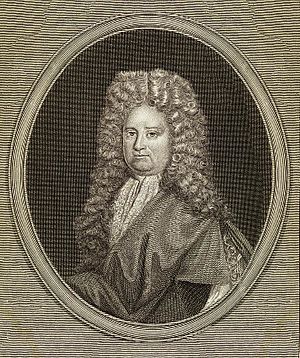Richard Richardson (botanist) facts for kids
Richard Richardson (1663–1741) was an English doctor, a plant expert (botanist), and someone who studied old things (antiquarian). He became a member of the Royal Society in 1712, which is a group for important scientists.
Contents
Who Was Richard Richardson?
Richard Richardson was born in North Bierley on September 6, 1663. He was the oldest son of William Richardson.
His Early Life and Education
Richard went to Bradford Grammar School. Later, he studied at University College, Oxford, but he didn't finish his degree there. He also studied law for a short time at Gray's Inn.
He then went to Leyden University in the Netherlands in 1687. There, he lived with Paul Hermann, a famous professor who taught about plants. Another well-known student there was Herman Boerhaave. Richard studied medicine and became a doctor. When he came back to England, he often treated people for free.
His Love for Plants and Gardens
Richard Richardson had enough money to travel around England, Wales, and Scotland. He was always looking for new and interesting plants, especially cryptogams (plants like mosses and ferns). He worked with other plant collectors like Samuel Brewer and Thomas Knowlton.
His home at North Bierley had a very famous garden. He planted a cedar of Lebanon tree there, which was sent to him by Sir Hans Sloane, another famous scientist. His garden also had cool water features and one of the first hothouses. In this hothouse, he grew special fruits from warm countries.
His Connections and Legacy
Richard was good friends with Ralph Thoresby, who was also an antiquarian. He wrote many letters to other important plant experts and antiquarians, including Sir Hans Sloane, Dillenius, Jan Frederik Gronovius, and James Petiver. Because of his important work, he was chosen to be a member of the Royal Society in 1712.
Richard Richardson passed away at Bierley on April 21, 1741. He was buried in Cleckheaton chapel in Birstall, a place he had helped rebuild. A special monument was put up to remember him.
What Did Richard Richardson Write?
Richard wrote a paper in Latin called De Febre Tertiana for his doctor's degree in 1690. He also wrote articles for the Royal Society's Philosophical Transactions about old things he found in Lancashire and Yorkshire.
He shared some of his letters and old writings with Thomas Hearne, who was also interested in history. These were printed in Hearne's books.
His Lasting Impact
Richard Richardson's love for plants and old things continued through his family. His descendant, Frances Mary Richardson Currer, inherited his large collection of books about plants and history. She also had his two handwritten lists of plants in his garden and many of his letters.
Many of his other letters are now kept in the British Library and at the Royal Society. Other experts like John Nichols and John Edward Smith also printed letters from him.
Richard Richardson was recognized by other plant experts. Dillenius said that Richard and William Sherard helped find many new plants in England and figure out where they grew. He also noted Richard's help in collecting mosses. A famous scientist named Linnæus even named a plant after him!
His Family Life
Richard Richardson married Sarah Crossley in 1700. Sadly, she passed away in 1702, and their baby son also died soon after.
He married his second wife, Dorothy Currer, in 1705. She was born in 1687 and lived until 1763. They had twelve children together, and seven of them lived to be adults.
His Children and Grandchildren
One of his sons, Richard Richardson the younger (1708–1781), had more building work done on Bierley Hall and added a chapel to the estate. One of his daughters, Dorothy, married Sir John Lister Kaye, 4th Baronet.
His grandson, Henry Richardson (1758–1784), later became known as Henry Richardson Currer. Henry's daughter, Frances Mary Richardson Currer, inherited the family estates. Another granddaughter, Dorothy Richardson (1748–1819), was interested in art and old things. She wrote travel journals about her journeys.


